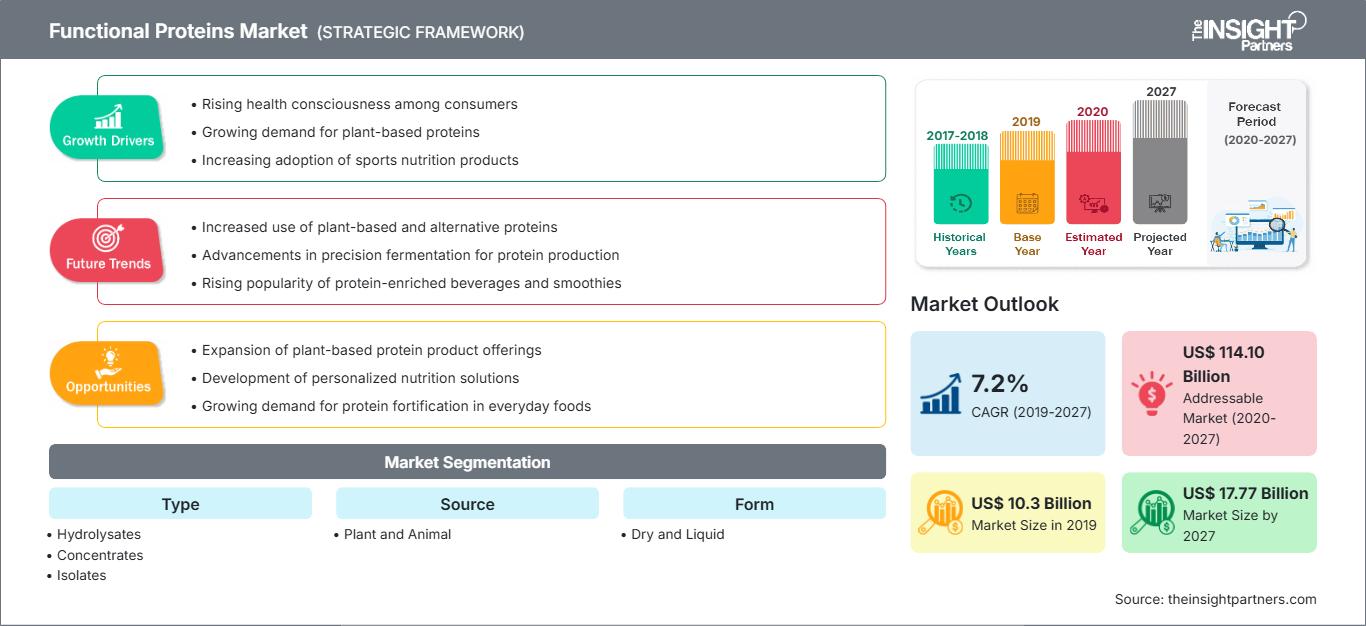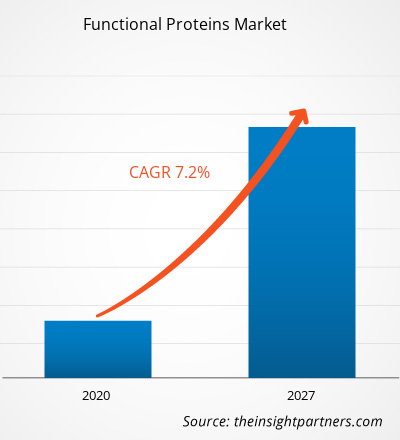[Forschungsbericht] Der Markt für funktionelle Proteine wurde 2019 auf 10.297,91 Millionen US-Dollar geschätzt und soll bis 2027 17.767,48 Millionen US-Dollar erreichen; von 2020 bis 2027 wird ein durchschnittliches jährliches Wachstum von 7,2 % erwartet.
Verbraucher legen zunehmend Wert auf Wellness, Gesundheit und Ernährung. Die Lebensmittelindustrie bringt ständig neue Produkte auf den Markt, um die Verbraucher zu einem gesunden Lebensstil zu motivieren. Protein ist einer der wichtigsten Inhaltsstoffe funktioneller Lebensmittel und kommt natürlicherweise in verschiedenen tierischen und pflanzlichen Quellen vor. Proteine sind für reibungslose Körperfunktionen unerlässlich und werden für die Struktur, Funktion und Regulierung von Körpergewebe und Organen benötigt. Das Bewusstsein der Verbraucher für die Vorteile funktioneller Proteine trägt erheblich zum Wachstum des Marktes für funktionelle Proteine bei. Darüber hinaus trägt das steigende verfügbare Einkommen der Verbraucher in den Schwellenländern im asiatisch-pazifischen Raum, im Nahen Osten, in Afrika und in Südamerika zum Marktwachstum bei.
Im Jahr 2019 hatte der asiatisch-pazifische Raum den größten Anteil am globalen Markt für funktionelle Proteine. Die Schwellenländer im asiatisch-pazifischen Raum erleben einen Anstieg der Mittelschicht und eine zunehmende Urbanisierung, was den wichtigsten Marktteilnehmern lukrative Möglichkeiten bietet. Aufgrund der wachsenden Bevölkerungsbasis und des steigenden verfügbaren Einkommens trägt die Region erheblich zum Konsum funktioneller Proteine bei. Das Wachstum des Marktes für funktionelle Proteine im asiatisch-pazifischen Raum wird maßgeblich durch das wachsende Gesundheitsbewusstsein und das steigende Interesse der Verbraucher an einer nahrhaften und gesunden Ernährung vorangetrieben. Darüber hinaus steigen die Umsätze mit Säuglingsnahrung mit einem hohen Anteil funktioneller Proteine im asiatisch-pazifischen Raum. In den Ländern des Asien-Pazifik-Raums steigt die Zahl berufstätiger Frauen, und viele berufstätige Mütter bevorzugen gesunde und praktische Nahrungsmittel für ihre Säuglinge, was das Marktwachstum zusätzlich fördert.
Der Ausbruch von COVID-19 wurde erstmals im Dezember 2019 in Wuhan (China) gemeldet. Im Hinblick auf die Zahl der bestätigten Fälle und der gemeldeten Todesfälle gehören die USA, Indien, Brasilien, Russland, Großbritannien, Frankreich, Spanien, Italien, die Türkei, Deutschland, Kolumbien und Argentinien seit Februar 2021 zu den am stärksten betroffenen Ländern. Laut den neuesten Zahlen der WHO gibt es weltweit ca. 108.579.352 bestätigte Fälle und insgesamt 2.396.408 Todesfälle. Der Ausbruch hat aufgrund von Ausgangssperren, Reiseverboten und Geschäftsschließungen die Wirtschaft und Industrie in zahlreichen Ländern negativ beeinflusst. Die globale Lebensmittel- und Getränkeindustrie ist eine der wichtigsten Branchen, die unter schwerwiegenden Störungen wie Lieferkettenunterbrechungen, der Absage von Technologieveranstaltungen, Büroschließungen usw. leidet. Die Schließung verschiedener Werke und Fabriken in führenden Regionen wie Nordamerika, Europa, dem asiatisch-pazifischen Raum, Südamerika, dem Nahen Osten und Afrika schränkt die globalen Lieferketten ein und behindert die Produktionsaktivitäten, Lieferpläne und den Verkauf verschiedener Waren. Auch der Transport stellt ein großes Problem dar, da viele Grenzen aufgrund der weltweiten Reiseverbote in Ländern Europas, Asiens und Nordamerikas geschlossen sind. Dies beeinträchtigt auch die Möglichkeiten zur Geschäftskooperation und zu Partnerschaften. All diese Faktoren haben das Wachstum des Marktes für funktionelle Proteine gebremst.
Passen Sie diesen Bericht Ihren Anforderungen an
Sie erhalten kostenlos Anpassungen an jedem Bericht, einschließlich Teilen dieses Berichts oder einer Analyse auf Länderebene, eines Excel-Datenpakets sowie tolle Angebote und Rabatte für Start-ups und Universitäten.
Markt für funktionelle Proteine: Strategische Einblicke

-
Holen Sie sich die wichtigsten Markttrends aus diesem Bericht.Dieses KOSTENLOSE Beispiel umfasst Datenanalysen, die von Markttrends bis hin zu Schätzungen und Prognosen reichen.
Funktionale Proteine sind eine komplexe Mischung biologisch aktiver Proteine, die die normale Immunfunktion unterstützen und aufrechterhalten. Heutzutage legt die Bevölkerung weltweit Wert auf einen gesunden Lebensstil und gibt beträchtliche Summen für Nahrungsmittel aus. Funktionale Proteine helfen, den Blutdruck zu senken, der eine Hauptursache für Herzinfarkte, Schlaganfälle und chronische Nierenerkrankungen ist. Nach Schätzungen der Centers for Disease Control and Prevention leidet fast die Hälfte aller Erwachsenen in den USA an Bluthochdruck und nimmt Medikamente dagegen ein. Darüber hinaus steigt die Zahl der Patienten mit Fettleibigkeit weltweit an. Fettleibigkeit führt zu verschiedenen Gesundheitsproblemen wie Herzerkrankungen, Typ-2-Diabetes, Schlaganfall und bestimmten Krebsarten. Laut den Centers for Disease Control and Prevention lag die Prävalenz von Fettleibigkeit in den USA zwischen 2017 und 2018 bei 42,4 %. Um solche Probleme zu überwinden, sucht die Bevölkerung nach neuen Methoden, um fit zu bleiben und einen gesunden Lebensstil zu pflegen. Solche Fälle dürften die Nachfrage nach mit funktionellen Proteinen angereicherten Lebensmitteln erhöhen und so das Marktwachstum fördern.
Typeneinblicke
Basierend auf den Typen ist der globale Markt für funktionelle Proteine in Hydrolysate, Konzentrate und Isolate unterteilt. Das Segment der Isolate war 2019 marktführend. Funktionelle Proteinisolate sind hochkonzentrierte Proteinfraktionen und Proteinkonzentrate aus pflanzlichen und tierischen Quellen, die durch Nassverarbeitung hergestellt werden können. Die Proteintrennung basiert hauptsächlich auf der Solubilisierung des Proteins, gefolgt von einem isoelektrischen Verfahren oder einem Ultrafiltrationsprozess zur anschließenden Rückgewinnung. Ein Molkenproteinisolat ist ein Nahrungsergänzungsmittel und eine Lebensmittelzutat, die durch die Trennung von Bestandteilen aus Molke hergestellt wird. Molke ist ein Milchnebenprodukt des Käseherstellungsprozesses. Proteinisolate, insbesondere das Erbsenproteinisolat, werden gut absorbiert und bieten eine Vielzahl von funktionellen Vorteilen wie verbessertes Sättigungsgefühl, Förderung des Fettabbaus und Muskelaufbaus.
Quelleneinblicke
Nach Quelle ist der globale Markt für funktionelle Proteine in pflanzliche und tierische Proteine unterteilt. Das Segment Tier dominierte den Markt im Jahr 2019. Tierische Proteine wie Fleisch, Eier und Milchprotein sind vollständige Proteine, da sie alle essentiellen Aminosäuren enthalten, die der Körper braucht. Tierische Produkte bieten immer die hochwertigsten Proteinquellen. Hydrolysate, Konzentrate und Isolate sind die drei wichtigsten Arten von funktionellem tierischem Protein auf dem Markt. In der Lebensmittel- und Getränkeindustrie sowie in der Tierfutterindustrie spielt tierisches funktionelles Protein eine entscheidende Rolle. Proteinergänzungspulver aus tierischem Protein werden bei gesundheitsbewussten Verbrauchern auf der ganzen Welt immer beliebter.
Formeneinblicke
Nach Form ist der globale Markt für funktionelle Proteine in trockene und flüssige Proteine unterteilt. Das trockene Segment dominierte den Markt im Jahr 2019. Trockenes Proteinkonzentrat wird häufig in Nahrungsergänzungsmitteln verwendet. Protein ist ein essentieller Makronährstoff, der beim Muskelaufbau, der Gewebereparatur und der Produktion von Enzymen und Hormonen hilft. Proteinpulver kann auch beim Abnehmen helfen und Verbrauchern dabei helfen, ihre Muskeln zu straffen. Molkenproteinkonzentrate werden grundsätzlich als Zutat in vielen Lebensmitteln verwendet, beispielsweise in Süßwaren, Snacks, Backwaren, Joghurt, Dips, Desserts, Fleischprodukten, Eiscreme, Suppen, Pastaprodukten, Soßen, Getränken und Schmelzkäseprodukten.
Anwendungseinblicke
Nach Anwendung ist der globale Markt für funktionelle Proteine in funktionelle Lebensmittel, funktionelle Getränke, Nahrungsergänzungsmittel, Tiernahrung und andere unterteilt. Das Segment der Nahrungsergänzungsmittel dominierte den Markt im Jahr 2019. Nahrungsergänzungsmittel sind Substanzen, die verwendet werden, um der Ernährung Nährstoffe hinzuzufügen oder das Risiko von Gesundheitsproblemen wie Osteoporose oder Arthritis zu senken. Proteinpräparate sind Produkte, die der Ernährung zusätzlichen Nährwert verleihen sollen. Das zunehmende Bewusstsein für durch Proteinmangel verursachte Krankheiten und der steigende Bedarf an Mahlzeitenersatz für unterwegs überzeugen Verbraucher davon, Proteinpräparate in ihren geschäftigen Lebensstil zu integrieren.
Die Akteure auf dem Markt für funktionelle Proteine setzen Fusions- und Übernahmestrategien sowie Forschungs- und Entwicklungsstrategien um, um ihren Kundenstamm zu erweitern und weltweit bedeutende Marktanteile zu gewinnen, was es den Akteuren auch ermöglicht, ihren Markennamen weltweit zu behaupten.
Markt für funktionelle Proteine
Die Analysten von The Insight Partners haben die regionalen Trends und Faktoren, die den Markt für funktionelle Proteine im Prognosezeitraum beeinflussen, ausführlich erläutert. In diesem Abschnitt werden auch die Marktsegmente und die geografische Lage in Nordamerika, Europa, dem asiatisch-pazifischen Raum, dem Nahen Osten und Afrika sowie Süd- und Mittelamerika erörtert.Umfang des Marktberichts über funktionelle Proteine
| Berichtsattribut | Einzelheiten |
|---|---|
| Marktgröße in 2019 | US$ 10.3 Billion |
| Marktgröße nach 2027 | US$ 17.77 Billion |
| Globale CAGR (2019 - 2027) | 7.2% |
| Historische Daten | 2017-2018 |
| Prognosezeitraum | 2020-2027 |
| Abgedeckte Segmente |
By Typ
|
| Abgedeckte Regionen und Länder |
Nordamerika
|
| Marktführer und wichtige Unternehmensprofile |
|
Dichte der Marktteilnehmer für funktionelle Proteine: Verständnis ihrer Auswirkungen auf die Geschäftsdynamik
Der Markt für funktionelle Proteine wächst rasant. Die steigende Nachfrage der Endverbraucher ist auf Faktoren wie veränderte Verbraucherpräferenzen, technologische Fortschritte und ein stärkeres Bewusstsein für die Produktvorteile zurückzuführen. Mit der steigenden Nachfrage erweitern Unternehmen ihr Angebot, entwickeln Innovationen, um den Bedürfnissen der Verbraucher gerecht zu werden, und nutzen neue Trends, was das Marktwachstum weiter ankurbelt.

- Holen Sie sich die Markt für funktionelle Proteine Übersicht der wichtigsten Akteure
- Fortschreitende Branchentrends auf dem globalen Markt für funktionelle Proteine, um Akteuren bei der Entwicklung effektiver langfristiger Strategien zu helfen
- Geschäftswachstumsstrategien in entwickelten und sich entwickelnden Märkten
- Quantitative Analyse des globalen Marktes für funktionelle Proteine von 2017 bis 2027
- Schätzung der Nachfrage nach funktionellen Proteinen in verschiedenen Branchen weltweit
- PEST-Analyse zur Veranschaulichung der Wirksamkeit von in der Branche tätigen Käufern und Lieferanten zur Vorhersage des Marktwachstums
- Jüngste Entwicklungen zum Verständnis des Wettbewerbsmarktszenarios und der globalen Nachfrage nach funktionellen Proteinen
- Markttrends und -aussichten in Verbindung mit Faktoren, die das Wachstum des globalen Marktes für funktionelle Proteine vorantreiben und hemmen
- Entscheidungsprozess durch das Verständnis von Strategien, die das kommerzielle Interesse im Hinblick auf das Wachstum des globalen Marktes für funktionelle Proteine untermauern
- Globale Marktgröße für funktionelle Proteine an verschiedenen Marktknotenpunkten
- Detaillierte Übersicht und Segmentierung des globalen Marktes für funktionelle Proteine sowie seine Dynamik in der Branche
- Globale Marktgröße für funktionelle Proteine in verschiedenen Regionen mit vielversprechendem Wachstum Chancen
Markt für funktionelle Proteine – nach Typ
- Hydrolysate
- Konzentrate
- Isolate
Markt für funktionelle Proteine – nach Quelle
- Pflanzlich
- Tierisch
Markt für funktionelle Proteine – nach Form
- Trocken
- Flüssig
Markt für funktionelle Proteine – nach Anwendung
- Funktionale Lebensmittel
- Funktionale Getränke
- Nahrungsergänzungsmittel
- Tierernährung
- Sonstige
Firmenprofile
- AMCO Proteins
- APC INC
- FrieslandCampina
- Abbott Nutrition
- Archer Daniels Midland Company
- Arla Foods Ingredients Group
- Cargill, Incorporated
- Glanbia plc
- DSM
- Real Dairy Australia Pty Ltd.
- Fonterra Co-operative Group Limited
- Kerry
- Saputo Ingredients
- Historische Analyse (2 Jahre), Basisjahr, Prognose (7 Jahre) mit CAGR
- PEST- und SWOT-Analyse
- Marktgröße Wert/Volumen – Global, Regional, Land
- Branchen- und Wettbewerbslandschaft
- Excel-Datensatz
Aktuelle Berichte
Erfahrungsberichte
Grund zum Kauf
- Fundierte Entscheidungsfindung
- Marktdynamik verstehen
- Wettbewerbsanalyse
- Kundeneinblicke
- Marktprognosen
- Risikominimierung
- Strategische Planung
- Investitionsbegründung
- Identifizierung neuer Märkte
- Verbesserung von Marketingstrategien
- Steigerung der Betriebseffizienz
- Anpassung an regulatorische Trends






















 Kostenlose Probe anfordern für - Markt für funktionelle Proteine
Kostenlose Probe anfordern für - Markt für funktionelle Proteine